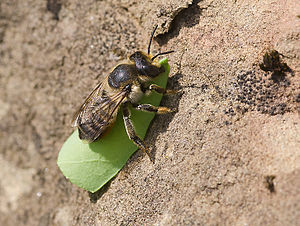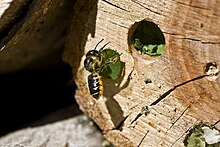Mortar and leaf cutter bees
| Mortar and leaf cutter bees | ||||||||||||
|---|---|---|---|---|---|---|---|---|---|---|---|---|

Leaf cutter bee ( Megachile sp. ) |
||||||||||||
| Systematics | ||||||||||||
|
||||||||||||
| Scientific name | ||||||||||||
| Megachile | ||||||||||||
| Latreille , 1802 |



The mortar and leaf cutter bees ( Megachile ) are a genus of bees from the order of the hymenoptera . They build their nest in two different ways:
The mortar bees build a nest of earth and stones, either free-standing or in cavities. You don't use pieces of leaf.
The leaf cutter bees , also called wallpapering bees , build their nests in cavities and cover them with cut pieces of leaf.
The mortar bees are separated from the genus Megachile by some authors and placed in a separate genus Chalicodoma . Many aspects speak in favor of a division into two groups, but there are so many transitional forms that an exact separation into two genres currently does not seem possible. The variety of morphological differences is taken into account by the division into numerous sub-genera.
features
The mortar and leaf cutter bees are insects with a very broad head, chest and abdomen and long mandibles spread at the base . In the female, the abdomen is significantly flattened on the back, on the stomach side it carries an often conspicuously colored abdominal brush, in which the pollen is transported: "Belly collectors". In the male, the last two abdominal rings are curved downwards, and there is no pollen transport device. In both sexes, the abdomen is often stretched obliquely upwards in a typical manner.
distribution
The genus is distributed almost worldwide. Some leaf cutter bees are common in Central Europe. Leaf cutter bees can also be found in Northern Europe or the Mediterranean. Mortar bees do not occur in Northern Europe, they have declined sharply in Central Europe and are now very rare, but some species can be observed more frequently in the Mediterranean region.
Way of life
Most species collect pollen from very different plants, but a few species are more specialized oligolectic .
Leafcutter bees build their nests in tree holes, crevices in the wall, caves in the ground, other existing cavities or they dig their nests themselves in stems containing pith, dead wood or in the ground. The brood cells are papered with cut pieces of leaves from various deciduous trees, shrubs or herbs. A supply of pollen and an egg are placed in each cell and the cell is then closed with further pieces of leaf.
The mortar bees' nests often look like conspicuous clumps of clay on stones or walls. The cells are often cleaned and reused in the following years.
The developed larvae spin a cocoon in their cell and hibernate there to hatch as bees in the next spring. The leaf cutter bees are mainly parasitized by the cone bees .
species
The following species have so far been recorded in Germany:
- Megachile alpicola Alfken , 1924
- Megachile analis Nylander , 1852
- Megachile apicalis Spinola , 1808
- Megachile bombycina Radoszkowski , 1874
- Megachile centuncularis Linnaeus , 1758
- Megachile circumcincta Kirby , 1802
- Megachile ericetorum Lepeletier , 1841
- Megachile genalis A. Morawitz , 1880
- Megachile lagopoda Linnaeus , 1761
- Megachile lapponica Thomson , 1872
- Megachile leachella Curtis , 1828
- Megachile ligniseca Kirby , 1802
- Megachile maackii Radoszkowski
- Megachile maritima Kirby , 1802
- Megachile melanopyga A. Costa , 1863
- Megachile nigriventris Schenck , 1870
- Megachile parietina Geoffroy in Fourcroy , 1785
- Megachile pilidens Alfken , 1923
- Megachile pyrenaea Pérez , 1890
- Megachile rotundata Fabricius , 1784
- Megachile versicolor Smith , 1844
- Megachile willughbiella Kirby , 1802
Megachile pluto ( Smith , 1861), which lives on the Bacan Islands (northern Moluccas ) and whose females reach a body length of 39 mm, is considered to be the largest species of bee in the world. Megachile chrysopogon occurs in Africa.
Megachile in the garden
Leafcutter bees are often found in the vicinity of human dwellings and in gardens ( synanthropy ) and are therefore one of the familiar phenomena for naturalists.
Leaf cutter bees are important pollinators of many cultivated and wild plants. For example, the leaf cutter bee Megachile rotundata is specially bred in North America and Europe to pollinate alfalfa . The occurrence of leaf cutter bees or even the rare mortar bees in gardens and agricultural crops is therefore welcomed by many gardeners. Leaf cutter bees can be encouraged by nesting aids and growing pollen plants in the garden.
Some rose growers consider leafcutter bees to be pests , as they cut exactly circular holes (up to 1 cm in diameter) into the rose petals from the edge. However, it is only a small damage to the foliage leaf, which hardly affects the affected plant. Control is therefore in most cases neither economically nor ecologically sensible and is prohibited in Germany due to the special legal protection under which the leaf cutter bees are.
Individual evidence
- ^ Charles Duncan Michener : The Bees of the World. Johns Hopkins University Press, 2000
Web links
- Checklist of the Apidae of Germany
- Photo series and further background information on the leaf cutter bee " Megachile centuncularis "
- Bee encyclopedia Genus and species Leaf cutter bees